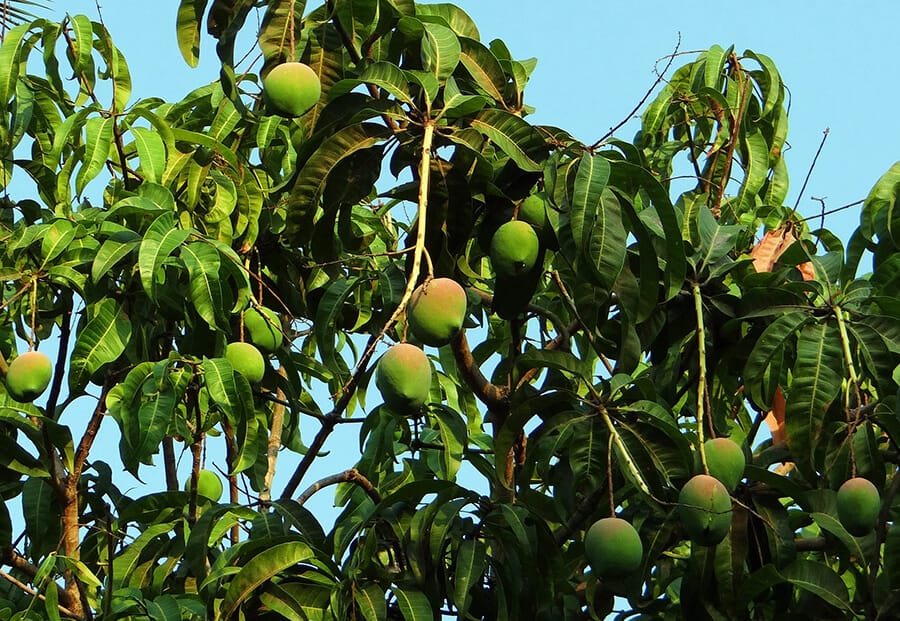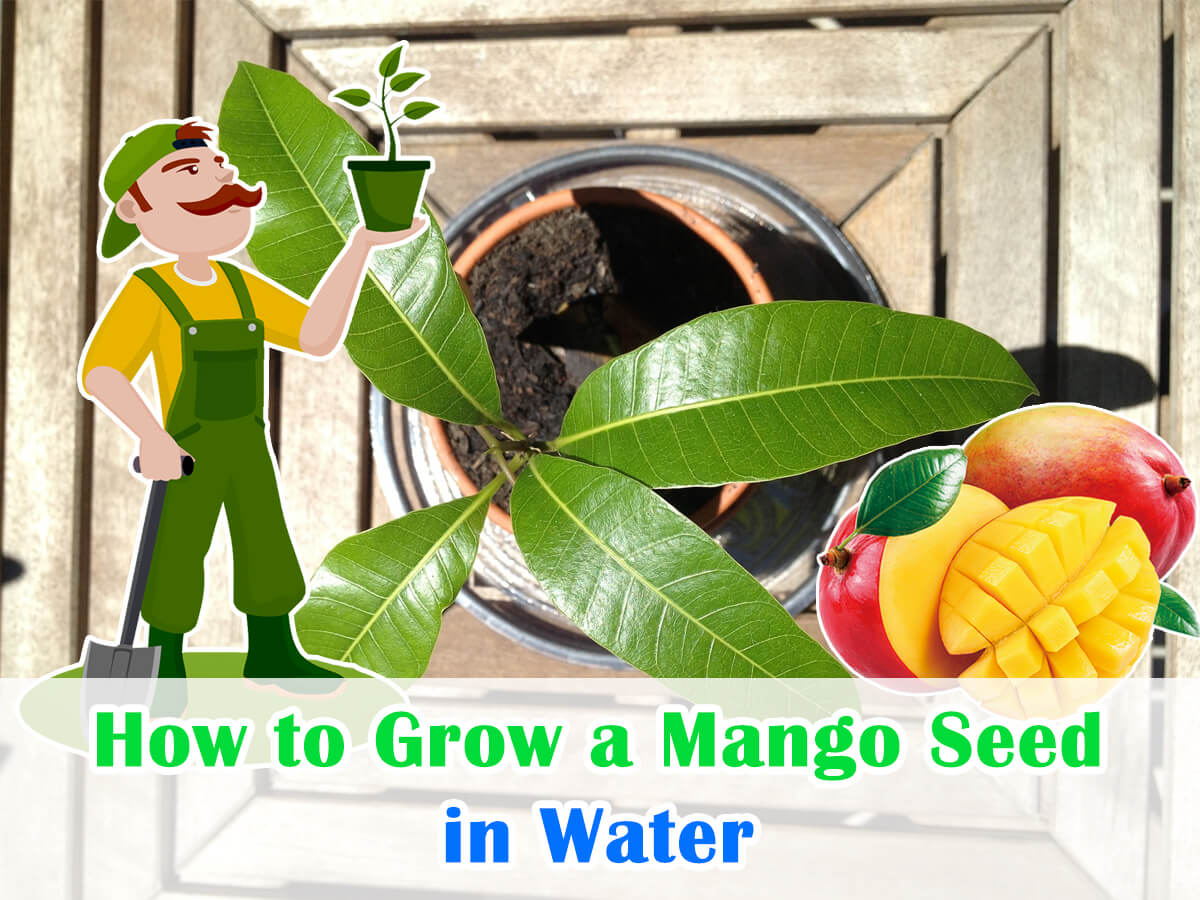I remember the first time I held a mango in my hands, freshly plucked from the tree in my grandmother’s backyard. The sweet, tangy aroma filled the air, and the vibrant orange flesh sparkled under the afternoon sun. As I bit into the succulent fruit, I felt a connection with nature that I had never experienced before. That was my introduction to the magical world of mangoes.
Ever since then, I’ve been fascinated by these tropical wonders. Over the years, I’ve learned that while devouring a ripe mango is an absolute delight, growing one from a seed is an entirely different kind of joy. It’s a journey of patience, care, and constant learning. Today, I’d love to share with you how to grow a mango seed in water, something that you can easily do in your own home.
How to Grow a Mango Seed in Water, Step by Step
Step 1. Select the Mango Seed
First things first, let’s talk about mango seeds. After you’ve enjoyed your juicy mango, you’ll find a large pit inside. This isn’t the actual seed but rather a protective outer cover known as the husk. The actual mango seed is snugly enveloped inside this husk.
To get to the seed, carefully pry open the husk using a dull knife. You’ll want to be gentle during this step, ensuring you don’t damage the seed inside. The mango seed will be a bit slippery and shaped somewhat like a large lima bean.
By the way, there are over 500 varieties of mangoes worldwide, each with its own unique characteristics. For example, the Tommy Atkins variety is highly disease-resistant and perfect for beginners, while Haden mangoes are known for their rich flavor and vibrant color. Alphonso, also known as the king of mangoes, is renowned for its sweet taste and is great for both eating fresh and using in recipes. On the other hand, Keitt is a late-season variety that stays green even when ripe.
So which mango should you grow? Simply put, your choice of variety should consider factors such as your local climate, available space, and personal taste preferences.
Step 2. Prepare and Wrap the Seed
Once you’ve carefully extracted the seed, rinse it under cool water to remove any leftover pulp. After that, pat it dry using a clean towel. Now comes an essential step of growing any plant from a seed – preparing the seed for germination.
Wrap the clean seed in a damp paper towel, making sure it’s completely covered. Next, place the wrapped seed inside a plastic bag, but don’t seal it completely. Leave a small opening for air circulation. This creates a humid environment, mimicking the tropical conditions mangoes love.
Step 3. Wait for the Seed to Germinate
Place the bag with the wrapped seed in a warm spot, away from direct sunlight. This could be on top of your fridge, inside a kitchen cabinet, or any other area that maintains a warm temperature.
The germination process takes anywhere from one to three weeks. During this time, make sure to keep the paper towel damp, not soaking wet, and observe the seed for any signs of mold. If you spot mold, don’t be disheartened. Simply clean the seed, replace the damp paper towel, and start over.
After about a week, you’ll see a small root sprouting from the seed. This is a sign that your mango seed is ready for the next step.
Step 4. Place the Germinated Seed in Water
Take a glass jar and fill it with water. Now, you’ll want to suspend the germinated seed on top of the jar, ensuring the root is submerged in the water, but the rest of the seed remains dry. You can do this using toothpicks or small skewers poked into the seed, allowing it to balance on the rim of the jar.
Position the jar in a warm spot with indirect sunlight. Change the water every couple of days to keep it fresh and prevent any bacterial growth.
Here is a video from Techplant that demonstrates this important part of the process:
Step 5. Wait for the Seed to Grow into a Seedling
In a couple of weeks, your mango seed will grow a stem and leaves, becoming a seedling. At this point, you’ll need to transplant it into a pot filled with rich, well-draining soil. When planting, ensure that the seed is partially exposed above the soil.
From here on, care for your mango plant by watering it regularly and providing it with ample sunlight. But remember, growing a mango tree is a marathon, not a sprint. It may take several years before your tree bears fruit.
Step 6. Nurture Your Mango Plant
Now that your mango seedling is in soil, it’s time to foster its growth into a mature, fruit-bearing tree. To do this, you’ll need to provide it with the right care and conditions.
Watering
Mango trees love moisture but do not do well in overly waterlogged conditions. Water your young plant deeply, but make sure to let the soil dry out between waterings. Overwatering can lead to root rot, which could be detrimental to your plant.
Sunlight
Your mango plant will thrive in plenty of sunlight. Ideally, it should get at least six hours of sunlight a day. If you’re growing your mango tree indoors, place it near a south-facing window or somewhere it can get ample sunlight.
Temperature
Mango trees are tropical plants and they love warm temperatures. They can tolerate temperatures as low as 30°F, but they thrive in temperatures between 70°F and 85°F. If you live in a colder climate, consider growing your mango tree in a pot so you can move it indoors during colder months.
Fertilizer
Your mango tree will benefit from regular feeding. To ensure your mango tree receives all the essential nutrients it needs, I personally recommend using Jobe’s 02610 Fertilizer Spikes. These spikes are an excellent slow-release fertilizer and are conveniently packed with the necessary nutrients, including nitrogen, phosphorus, and potassium.
What I love about these spikes is the ease of use. Simply stick the spikes into the soil. Make sure you follow the instructions on the package for application rates and frequency. Believe me, your mango tree will thank you!
Pruning
While mango trees don’t require extensive pruning like some fruit trees, a little trim now and then can help maintain a manageable size, especially if you’re growing it indoors. Pruning also helps to increase air circulation and light penetration, which can promote healthier growth.
The Long Wait to Fruition
Growing a mango tree from a seed is a rewarding experience, but it requires patience. Depending on the variety and growing conditions, it may take anywhere from five to eight years for your tree to bear fruit. But trust me, when you finally taste the first home-grown, sun-ripened mango from your own tree, it’ll be worth every moment of the wait.
Growing a mango seed in water is not only a fun project but also a symbolic journey of growth and patience. It’s a reminder that beautiful things take time. And in the end, isn’t it wonderful to know that something as delicious as a mango can start from something as simple as a seed and some water? So, go ahead, savor that next juicy mango, but don’t discard the seed. Instead, embark on this delightful gardening adventure.
Additional Mango Propagation Techniques
While this article focuses on growing a mango tree from seed, it’s worth noting that there are other propagation techniques. Grafting is a common method used to propagate mango trees commercially. This involves attaching a shoot or bud from a mature, fruiting mango tree to a young rootstock.
The main advantage of grafting is that it allows for the new tree to produce fruit that’s identical to the parent tree, which is particularly useful for preserving the characteristics of specific mango varieties. However, grafting is a more complex process and may require a certain level of skill and knowledge to execute successfully.
The following image gives a general idea how grafting is done:

Another propagation method is air layering, which is a technique that encourages a branch to start growing roots while still attached to the parent plant. Once roots have developed, the branch can be cut off and planted as a separate tree.
This method can be more successful than growing from seed as it ensures the new tree will bear fruit true to the parent plant. However, like grafting, air layering requires more effort than simply growing a mango tree from seed.
Mango Growing Problems and Their Solutions
Growing a mango tree from a seed is a rewarding endeavor, but like all plants, they can be susceptible to certain problems. One common issue is the anthracnose disease, a fungal infection that can cause dark, sunken spots on leaves, stems, and fruit. Regularly pruning your mango tree to improve air circulation and applying a fungicide can help control this disease.
Pests can also pose a challenge. Scale insects, mealybugs, and aphids are a few of the common pests that might attack your mango tree. These tiny critters can damage your plant and stunt its growth. Using insecticidal soap or a strong jet of water can help dislodge these pests. In more severe cases, you may need to use a suitable pesticide, but always consider the environmental impact and safety for other creatures.
Indoor vs Outdoor Mango Growing
Growing a mango tree indoors can be a great option if you live in a cooler climate. When grown indoors, mango trees are more manageable in size and can be moved around to maximize sunlight exposure. They also add a beautiful tropical touch to your indoor space. However, indoor mango trees require careful watering and adequate light to prevent them from becoming leggy and weak.
On the other hand, outdoor mango trees can reach their full size and are more likely to bear fruit. They have more access to natural sunlight and can benefit from the elements in a way that indoor trees can’t. Still, they are susceptible to colder temperatures and will need protection during winter if you live in a non-tropical climate.

Harvesting and Storing Mangoes
Harvesting mangoes is a delicate process. The fruit should be picked when mature, which is typically when the skin gives a little under gentle pressure. The color of the fruit can also be an indicator, although this varies with different varieties. After harvesting, mangoes can be left at room temperature to ripen further.
When it comes to storing, ripe mangoes can be kept in the refrigerator to slow down the ripening process and prolong their shelf life. They can also be frozen for use in smoothies or desserts. To freeze mangoes, simply cut the flesh into cubes, spread them out on a tray, freeze until solid, and then transfer to a freezer-safe bag or container.
Benefits of Mangoes
Mangoes are not just delicious; they’re packed with nutrients too. They are rich in vitamins A and C, which are vital for immune function. They also contain a good amount of dietary fiber, promoting digestive health.
Moreover, mangoes are high in antioxidants like mangiferin, which has been studied for its potential anti-inflammatory, anticancer, and antidiabetic effects. Including mangoes in your diet can contribute to overall health and wellness, making all the effort of growing them even more worthwhile.
Final Words
In conclusion, growing a mango tree from a seed can be an exciting and rewarding endeavor, albeit one requiring patience and care. But with the right knowledge and resources, you can successfully grow and care for a mango tree, and eventually enjoy the fruits of your labor – quite literally.
Whether you choose to grow your tree indoors or outdoors, from a seed or through grafting, the journey will no doubt be a learning experience filled with moments of anticipation, challenges, and ultimately, sweet success.
Happy gardening!


